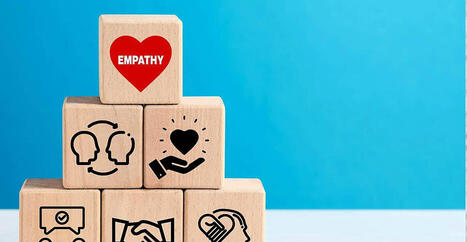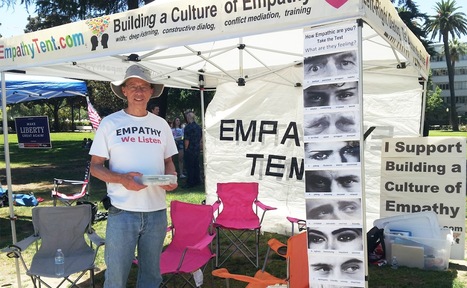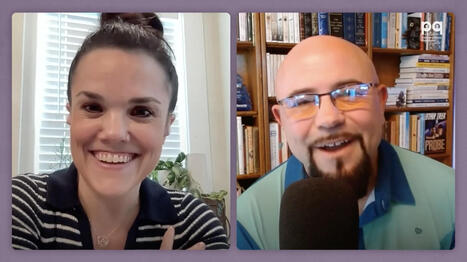 Your new post is loading...
 Your new post is loading...

|
Rescooped by
Edwin Rutsch
from Compassion
September 28, 2024 3:35 PM
|

|
Scooped by
Edwin Rutsch
November 27, 2:38 PM
|
A first-of-its-kind empathy education programme from the University of Galway is being rolled out to Transition Year students nationwide, aimed at boosting compassion and emotional skills in schools across the country.
We discussed this with Brendan Kelly, Professor of Psychiatry at Trinity College Dublin.

|
Scooped by
Edwin Rutsch
November 27, 2:36 PM
|
But the attack on empathy has been largely through the social weapon of radical individualism. In the modern day, among other things, it is through the vehicle of what’s now called Christian nationalism, a heretical form of false religion which situates “salvation” in the vertical relationship between the individual person and his or her “savior.” That is by contrast to the mainstream Judeo-Christian tradition that places empathy, empathy toward the less fortunate and for justice and peace, at the center of faith and purpose.

|
Scooped by
Edwin Rutsch
November 26, 6:57 PM
|
In this study we critically examine the phenomenological foundations of intuitive diagnosis in Psychiatry by integrating Max Scheler's concept of emotional contagion with Edith Stein's three-stage model of empathy. We argue that what Scheler calls emotional contagion offers a useful pre-reflective, bodily-affective resonance that precedes and facilitates deeper empathic understanding of the subject's experience. Then, we suggest that Stein's analysis of empathy, which is based on a three-step process – i.e., the emergence of the other's experience, its imaginative explication, and the final comprehensive objectification – may account for the role of imaginative empathic immersion in diagnostic assessment.

|
Scooped by
Edwin Rutsch
November 26, 6:55 PM
|
Empathy has become a business competency, not a soft nice-to-have. With hybrid teams, rapid AI adoption, and a workforce increasingly vocal about identity and inclusion, companies are being pushed to rethink what effective leadership looks like right now. Research and workplace trend reports consistently show that employees who feel seen and supported are more engaged and more likely to stay—raising the stakes for leaders who are hiring, managing, and shaping culture in real time.
What does empathetic marketing really look like in practice—not just as a buzzword, but as a way of working and leading?

|
Scooped by
Edwin Rutsch
November 26, 6:52 PM
|
Cillian Murphy is a patron of the Unesco Child and Family Research Centre at University of Galway and a supporter of the empathy education initiatives.
The ‘Activating Social Empathy’ schools programme is supported by the Irish American Partnership and Lifes2good Foundation, and partners of the Unesco Child and Family Research Centre, Foróige and Penn State.
Dr Charlotte Silke, lead researcher with Unesco Child and Family Research Centre, said: “The core aim is to support young people in becoming more attuned to the feelings and perspectives of others, and more confident in expressing empathy across a variety of real-world contexts.”

|
Scooped by
Edwin Rutsch
November 25, 11:28 PM
|
by Alison Jane Martingano A closer look at the research on empathy and gender reveals a more nuanced story shaped by socialization and stereotypes rather than biology. - Women report that they are more empathic on questionnaires.
- Physiological and behavioral indicators show minimal or no gender differences in empathy.
- Women’s modest advantage in emotion recognition reflects socialization and stereotype cues more than biology.
- Stereotypes create unfair expectations for women and discourage men from adopting caring roles.
-
If you ask people who’s more empathic, men or women, you’ll probably hear a confident answer. Cultural narratives, from everyday conversation to the statements of public figures like the Dalai Lama, often portray empathy as something women naturally possess in greater supply.

|
Scooped by
Edwin Rutsch
November 25, 11:21 PM
|
At a time when social trust feels increasingly fragile, leadership grounded in integrity, empathy, and consistency is critical. This webinar features leaders who have successfully built trust by prioritizing “learning from listening” and centering empathetic communication within their communities.
Join us for a conversation with leaders who are putting trust into practice. We’ll explore how they’ve built strong, credible reputations; how they foster trust at both individual and community levels; what larger institutions can learn from these grassroots strategies; and how locally grounded approaches can be adapted to strengthen trust at scale.
Moderator: Pearce Godwin, Founder, Listen First Project & Listen First Coalition; Senior Director, Urban Rural Action

|
Scooped by
Edwin Rutsch
November 25, 11:14 PM
|
Enter Empathetic AI Policy
Empathetic AI Policy—the emerging discipline that insists human impact must be designed, measured, and governed as rigorously as performance—exists precisely because of these failures. It’s not about making machines emotional, but about making human decision-makers accountable. It means recognizing that every model has moral weight, every dataset represents real lives, and every automated decision carries consequences that ripple through families, institutions, and society. In short, empathy is not a soft constraint—it’s the structure that keeps AI aligned with humanity.
The irony of modern AI is that it often reflects the very flaws it was meant to transcend: bias, carelessness, and moral blindness. The industry’s most infamous collapses—from racist chatbots to wrongful prosecutions and mass surveillance—share a single root cause: empathy was ignored, underestimated, or engineered out of the process. These are not merely “bugs in the system.” They are symptoms of a worldview that treats technology as neutral, when in reality, it always encodes human priorities.

|
Scooped by
Edwin Rutsch
November 25, 11:00 PM
|
Education today stands at a crossroads. As artificial intelligence transforms how we learn and live, the very essence of education is being reimagined. Are we preparing young people merely to compete, or to connect? To master technology, or to master themselves?
Educators and policymakers everywhere are rediscovering a timeless truth: intelligence opens doors, but empathy keeps them open. Emotional intelligence, the ability to understand and manage emotions, to lead with compassion, and to act with integrity is emerging as the most critical skill of the 21st century. It bridges knowledge and wisdom, between information and understanding, between success and significance.

|
Scooped by
Edwin Rutsch
November 25, 8:24 PM
|
This paper introduces the Selective Empathy Theory, a new theoretical framework that challenges the idealized, universalist understanding of empathy in psychology and social discourse. Contrary to the prevailing notion of empathy as an automatic and morally virtuous emotional response, this theory argues that affective empathy operates selectively—shaped and constrained by the perceiver’s moral frames, group identity, and socio-cultural context. Through interdisciplinary case studies spanning literature, film, political polarization, and digital discourse, the paper illustrates how empathy is not universally distributed but strategically directed toward those who align with one’s values and identity. The model emphasizes that selective empathy is not a moral failure, but a structural feature of emotional cognition, with profound implications for affective politics, media influence, and public morality.

|
Scooped by
Edwin Rutsch
November 25, 8:19 PM
|
by Michael Wiederman
Research has revealed that with increasing power comes decreasing likelihood of empathy.
This is an inherent human bias, so it is a true blind spot.
Leaders who fail to take other peoples' perspectives are at a disadvantage.
Try the strategies described here to work around the power-empathy bias.
Have you ever noticed someone in power who seems rather indifferent to the opinions of others? Perhaps you’ve witnessed a leader who doesn’t seem tuned in to the experiences of the people they lead.

|
Scooped by
Edwin Rutsch
November 25, 8:16 PM
|
by Alison Jane Martingano
Research shows that empathy training programs can increase empathy.
Empathy training programs that include practice and feedback tend to be most effective.
Experiences such as travel, learning sign language, and pet ownership may also train empathy.
There are no empathy "quick fixes." Improvements require effort and practice.
Many people treat empathy the way they treat height or eye color; in other words, as something baked in from birth. We hear this in everyday phrases like “she’s such a good kid” or “he’s just not very sensitive,” as if empathy were an inborn trait rather than something shaped over time. In our survey, more than a third of respondents were skeptical that empathy could be improved. Yet decades of research across psychology, education, and neuroscience tell a very different story. Empathy, it turns out, is more like your biceps than your hair color. Sure, you're born with them, but their size and strength are a result of hard work.
|

|
Scooped by
Edwin Rutsch
November 27, 2:42 PM
|
Psychology, linguistics, neuroscience and philosophy have led a recent shift in autism research. Instead of autistic communication being studied at the individual level, interactions are examined at the dyadic level within a ‘double empathy’ framework,, which refers to the ‘disjuncture in reciprocity between two differently disposed social actors who hold different norms and expectations of each other,’ such as autistic and non-autistic people. Reference Milton, Heasman, Sheppard and Volkmar3 By comparing how autistic and non-autistic people interact with people of the same (i.e. autistic pairs, non-autistic pairs) and different (i.e. one autistic person, one non-autistic person) diagnostic statuses, we can learn more about how the diagnostic status of an interaction partner shapes the way that people communicate.
Research shows two key findings. First, communication difficulties are not exclusive to autistic people; non-autistic individuals also struggle to understand autistic social behaviours, leading to a ‘double’ problem in mixed-neurotype interactions.

|
Scooped by
Edwin Rutsch
November 27, 2:37 PM
|
Why it's important: As machines and models take on more routine tasks, the human edge lies in collaboration, adaptability and compassion. Entrepreneurial leadership (Babson's specialty) helps leaders hone their head and heart alike.
"Active listening and empathy are essential for entrepreneurial leaders to identify starting points for creating viable business opportunities," Babson On-Demand™ co-director Philip Kim, who is also the school's Lewis Family Distinguished Professor in Social Innovation, said.

|
Scooped by
Edwin Rutsch
November 26, 7:07 PM
|
by Alison Jane Martingano Dozens of reliable and valid empathy measures exist, each designed to assess different components of empathy.
Self-report measures can capture momentary feelings and more habitual traits.
Performance-based measures assess how accurately people infer others’ emotions.
Observer ratings (from teachers, parents, patients, etc.) measure how empathic someone appears.
Many people assume empathy is too soft, too subjective, or too deeply personal to quantify. In our own survey, nearly half of the respondents agreed that “it is impossible to measure empathy.” This sentiment echoes a familiar cultural belief: that empathy is like love, beautiful precisely because it resists dissection. As one commentator put it, attempts to measure empathy require “stripping it of softness, feelings, and any sense that it’s a touchy-feely-can’t-exactly-measure-it” quality. And if you strip that away, she argued, “it’s no longer empathy.”

|
Scooped by
Edwin Rutsch
November 26, 6:56 PM
|
Empathy enables innovation, inclusion and the next-generation workforce
Innovation flourishes when diverse perspectives are valued and a culture of psychological safety is present. Most organizations today are composed of culturally diverse teams, each with distinct communication styles and perspectives on the world. Leaders who adapt their approach to meet the needs of different people open doors to authentic dialogue and deeper understanding.

|
Scooped by
Edwin Rutsch
November 26, 6:53 PM
|
How to Tap into Your Empathy for the Holidays | Bloom

|
Scooped by
Edwin Rutsch
November 26, 6:50 PM
|
Empathizing with another is perhaps the most human emotion of all and a long shot from the cold calculations of vectorized tokens that drive the inner workings of contemporary LLMs. This chapter looks beyond the questions of what to make of AI-generated “empathy” and instead asks whether AI can be used to develop our capacities for genuine human empathy. Empathy is not a static trait, instead capable of growth and development, and this paper explores whether AI can and, more importantly, should be used to increase one’s empathy. Nothing in principle stands in the way of AI improving our empathy, but the possibility raises unanswered questions about whether such an approach would be effective or would backfire in unexpected ways, such as encouraging the commodification of empathy as a technological tool that can make companies money, rather than a fundamental part of the human experience.

|
Scooped by
Edwin Rutsch
November 25, 11:25 PM
|
Empathy Isn’t the Problem - Enmeshment Is
What the author called “empathy” is something very different, something psychologist Murray Bowen described decades ago as enmeshment.
Enmeshment is the emotional fusion that happens when two people lose sight of where one person’s emotional life ends and the other’s begins. It’s not connection—it’s collapse. The self collapses into the other. Boundaries disappear. The relationship starts operating from a rigid, unhealthy script: one person must feel a certain way, act a certain way, uphold a certain emotional role—for the sake of the other.

|
Scooped by
Edwin Rutsch
November 25, 11:15 PM
|
In a world that feels sharper and more self-centered than ever, empathy seems to be disappearing, especially online. Political turbulence, social media culture, and a growing focus on self-preservation have created an environment where kindness is scarce, and disagreement feels like a battle. I explore how this leads to nonproductive arguing, and why practicing empathy, even in small ways, is more important than ever.
I can’t be the only one who’s noticed that the world feels a little meaner now than it did four or five years ago. Scrolling through the comment section of any news article feels like entering a battlefield of opposing opinions and people trying to one-up each other with the harshest take — a place where empathy rarely survives. Anyone who’s as chronically online as me has probably noticed how contrasting this feels compared to the online climate of 2020, when there seemed to be more openness and tolerance. Now, everyone feels more narcissistic, and it makes me wonder: What happened to empathy? Especially among young people?

|
Scooped by
Edwin Rutsch
November 25, 11:13 PM
|
1. BRIDGE THE CULTURES—DON’T BULLDOZE THEM
The first step was recognizing that we were merging two strong cultures, not replacing one with another. We approached it with humility and respect for the expertise already on the factory floor. We listened, observed, and spent time in each other’s spaces—our HQ team getting hands-on experience in the manufacturing environment, and our manufacturing team visiting HQ to see the broader mission in action.
That physical time together mattered. Culture isn’t built over Zoom; it’s built through shared meals, laughter, and the simple act of showing up.

|
Scooped by
Edwin Rutsch
November 25, 10:58 PM
|
Zero-positive empathy, according to Simon Baron-Cohen, is a structured empathy rooted in rules, not resonance. For autistic people, this framing has been both validating and limiting. Some have embraced the idea, finding clarity in the distinction between emotional intuition and ethical principle. Others feel flattened by it: misread, misunderstood, miscast. Many autistic individuals experience a deep, often overwhelming emotional attunement that defies diagnostic expectations.

|
Scooped by
Edwin Rutsch
November 25, 8:20 PM
|
Empathy is essential in healthcare, allowing clinicians to communicate successfully with patients and understand their needs, and research has linked clinician empathy with higher patient satisfaction, better health outcomes, and fewer medical errors. Unfortunately, studies also show that empathy tends to decrease during medical school, as fact-based learning and high-stakes testing drive students’ attention away from patients’ subjective experiences. “You’re just in survival mode,” explains Riham Alieldin, a physician and medical educator at the University of Rochester.

|
Scooped by
Edwin Rutsch
November 25, 8:17 PM
|
AI is changing healthcare and potentially even how humans interpret empathy. The motivation for this research is to evaluate whether and, if applicable, to what extent AI can show elements of empathy. While some may consider AI never genuinely empathetic, the goal is to know when AI expressions of empathy are productive versus harmful (Inzlicht et al. 2024) Differences in perspective make defining empathy especially challenging. Empathy in healthcare is becoming a more significant focus, with related metrics like quality of care, patient-centered care, and patient satisfaction as core objectives. The paper explores whether chatbots can help bridge the gap in defining and offering empathy while reimagining care for a digital future.

|
Scooped by
Edwin Rutsch
November 21, 10:08 PM
|
|






 Your new post is loading...
Your new post is loading...


























